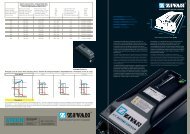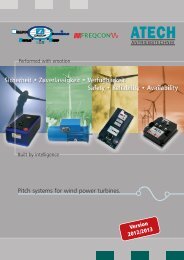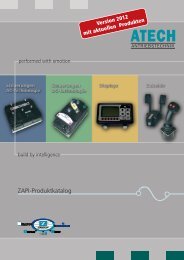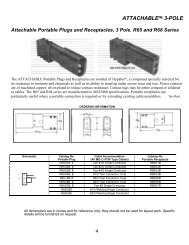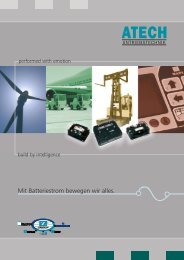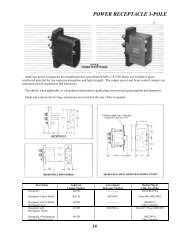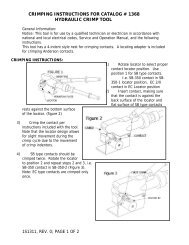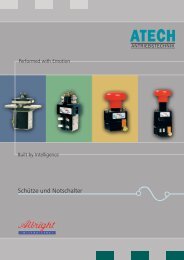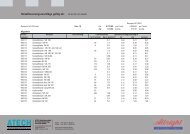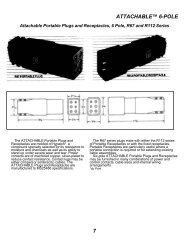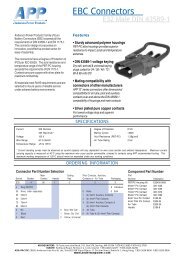Batteriestecker - Atech Antriebstechnik
Batteriestecker - Atech Antriebstechnik
Batteriestecker - Atech Antriebstechnik
You also want an ePaper? Increase the reach of your titles
YUMPU automatically turns print PDFs into web optimized ePapers that Google loves.
| Why Crimp Dimensions Are Not Suitable as Primary Inspection Criteria |<br />
Crimp dimensions are not an adequate or reliable means to evaluate if a good crimp has been made. For this reason they should<br />
not be relied upon as a primary inspection method.<br />
When you crimp a contact, the material is forced down to the size of the fully closed die. This die closure on most tools is a fixed<br />
dimension. When the die is released, the material (contact and wire) will expand back out when they are no longer restrained by<br />
the die. The amount that it expands outwards or “bounces back” is dependant on the resistance or force that the material in the<br />
contact and wire places against the crimp die. The resistance of the material to being formed by the crimp will vary with wire type<br />
and stranding, hardness of the metal (both contact and wire), as well as the temperature. It is for this reason that the crimp height<br />
is a variable and cannot be relied upon solely to determine if a crimp is good or not.<br />
| Crimp Dimensions as Secondary Inspection Criteria |<br />
Crimp dimensions should only be used as secondary inspection criteria due to the above variables. These variables make it<br />
is impossible for Anderson Power Products to determine what the correct crimp dimension should be without evaluation of the<br />
specific instance. Accordingly harness manufacturers are responsible for determining the appropriate crimp dimensions to be<br />
used and only as a secondary inspection method. Crimp dimensions are an acceptable means of short interval inspection for<br />
determining homogeneity within a batch provided:<br />
1. Electrical resistance and pull out strength are tested on samples from the batch to ensure the crimp dimensions are<br />
indicative of a good crimp.<br />
2. The same tooling is used throughout the batch and operated in the same manner, at the same calibration level.<br />
3. The same wire is used throughout the batch. (Wire can vary significantly by factors ranging from class to manufacturer).<br />
4. Assembly instructions are closely followed, especially wire stripping and preparation.<br />
| Other Critical Crimp Dimensions |<br />
There are other critical crimp dimensions that impact if a crimp is good or not. All APP ® contacts are designed to work with a specific<br />
crimping solution to minimize the distortion of crimping force on the critical geometries of the contact. If the incorrect crimp solution<br />
is used or the correct crimp solution is improperly used, then this will distort the intended geometries of the contact.<br />
SECTION 4<br />
Tooling<br />
The geometry of the contact blade and its relative angle to the crimp barrel must be maintained after the contact is crimped. If these<br />
dimensions are not maintained the contact will not latch properly in the housing. This can impact how well the contact is secured<br />
in the housing as well as the normal force (measurement of the opposing force that pushes the contacts together) between the<br />
mating blades of two mating contacts. The normal force is directly related to the electrical properties of the connector and poor<br />
normal force can lead to higher electrical resistance, overheating, and reduced current capability. These geometries can only be<br />
assured by using the correct crimp tool, with proper die and locator.<br />
OK<br />
Nose Up<br />
Nose Down<br />
- 100 - www.andersonpower.com<br />
All Data Subject To Change Without Notice



